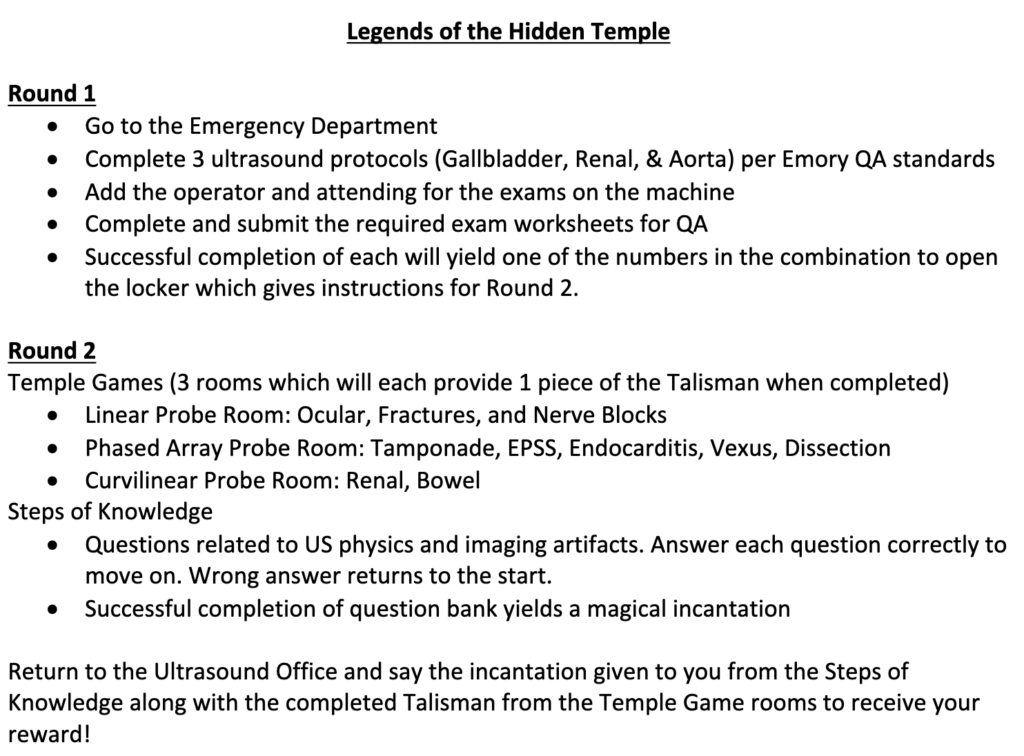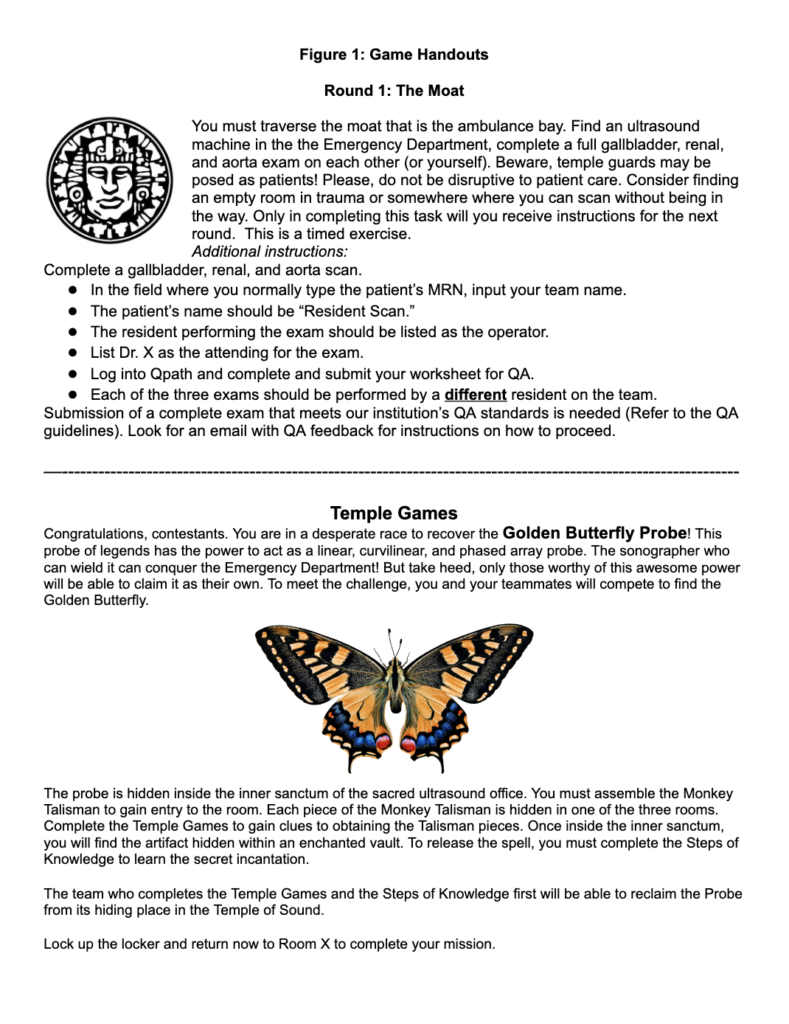Gamification, or the use of interactive educational sessions with a healthy dose of competition, can help motivate learners and lead to increased retention of skills and knowledge.
Point of care ultrasound (POCUS) is integral to many health professions and a requirement in the training of emergency medicine resident physicians (Bahner et al., 2012). The use of POCUS improves patient care by allowing for prompt diagnosis and management of frequently time-sensitive pathologies and more accurate performance of procedures with fewer complications (Bahner et al., 2012). In emergency medicine, POCUS is traditionally taught through formal didactics, bedside teaching, and the repeated practice of imaging protocols. Becoming competent in POCUS requires attention to medical knowledge, psychomotor skills for image acquisition, image interpretation, and integration of the information gained into clinical decisions (Nicholls et al., 2014). While traditional didactics can address medical knowledge, image interpretation, and clinical applications, this multifaceted skill set demands a more complex curriculum to better address all its components.
In addition, keeping learners engaged in developing POCUS skills throughout their three years of residency can be difficult. We have found that many residents are excited early on and are engaged with educational sessions during their intern year. However, as they move on in their residency, they have increasing clinical demands and requirements in other areas, and start to put continuing ultrasound education to the side. In order to address these concerns we turned to game based education to maintain our residents’ interest in POCUS education.
Game-based education aims to maintain learners’ intrinsic motivation to learn by providing educational content that fits within their Zone of Proximal Development (Singhal et al., 2019). The Zone of Proximal Development, described by Vygotsky, suggests that there are tasks that learners cannot yet complete because they are too challenging which can cause anxiety, and tasks that learners have already mastered which can evoke boredom (Groot et al., 2020). Vygotsky argues that being able to teach at a level between these two zones, known as the Zone of Proximal Development, allows for enhanced engagement and in turn can promote improvement and growth in the learner (Groot et al., 2020).
Over the last decade, gamification of learning has increased in health professions education (van Gaalen et al., 2021). For definition purposes, a game can be described as an interactive experience (with or without a significant hardware/software component) that has a challenging goal, is fun to play, incorporates some scoring mechanism, and is expected to provide the user with skills, knowledge, or attitudes that are useful in real life (van Gaalen et al., 2021). Several game design elements, the taxonomy of which was first developed by Wilson et al. and subsequently adjusted by Landers et al., can be utilized to augment education including that of “action language,” “assessment,” “conflict and challenge”, “human interaction”, and importantly “rules and goals” (Wilson et al., 2009; Landers et al., 2014).
Action language is the way that the game interfaces with the learner. Assessment is the real time feedback the game provides based on learner performance. Conflict and challenge address both the problems the learner faces and acknowledge the nature and difficulty of these problems as the learner progresses through a game. Human interaction allows learners to work as a team and interface with other players. The rules and goals element requires clear definitions so that the learner understands how to progress through the game. The incorporation of these gamification elements not only engages the learners but also has the ultimate goal of addressing the learners’ skills, knowledge, and/or attitude toward the topic being taught, in this case POCUS.
Our residency program includes class-specific teaching days, an optimal time to incorporate a game-based POCUS curriculum to better target the learners’ Zone of Proximal Development. The objectives for curriculum include learning more advanced ultrasound protocols, reviewing pathologic images, and focusing more on clinical integration. Over the last few years, we have incorporated multiple different game structures, from team-based contests to modified board games.
One recent intervention involved an ultrasound-adapted escape room, which was held virtually in 2021 when social distancing demanded virtual didactics, and again in 2022 in-person once social distancing mandates were lifted. In the in-person session, the theme was inspired by the 1990s Nickelodeon children’s game show, “Legends of the Hidden Temple.” Residents from the second-year class were divided into three teams. Teams received pieces of a statue at different stations after solving a problem, answering questions, or performing ultrasound scanning techniques or skills. Once all the pieces were obtained, they were able to build the statue and unlock the final room where they completed a final clinically-based scanning task to win the game.
The game began with the following script: “Welcome to Legends of the Hidden Temple!! This sacred temple is filled with lost treasures protected by mysterious…temple guards. You have been divided into three teams (Blue Barracudas, Purple Parrots, and Silver Snakes) and are in a desperate race to recover an ancient artifact hidden within these temples. To learn more about the tasks you must accomplish, you must first traverse the moat. Before we begin, note that the goal of this morning is first and foremost education. Do not attempt to sabotage other teams or you will pay a grave consequence.” The tasks that were included in the game are listed in Table 1 and the instructions to the participants in Figure 1.


To assess the intervention, pre- and post-tests were given to the 15 participants, and there was a noted improvement in medical knowledge from an average test score of 56.7% prior to the class day to 70.8% after completion of the curriculum. Although these numbers may seem low, the test was designed to test the knowledge of a fellowship trained individual, so these pre- and post-test averages are appropriate for the difficulty of the exam for a second-year emergency medicine resident. There was also high attendance on the class days and strong positive feedback from the residents who participated and from the associate program director.
While the sessions built upon prior years, and we were able to reuse many clinical scenarios, challenges, and questions addressing general ultrasound knowledge, clinical scenarios, and national board preparation material, the class days were still resource intensive. Preparation required a significant amount of time from five faculty members and three fellows, the provision of enough ultrasound machines by our vendor contacts, and the identification of adequate space, in this case four offices and a classroom.
While the initiation energy was high, the engagement and positive feedback from the sessions and the ability to replicate similar sessions for subsequent years with significantly lower amounts of preparatory time was well worth the effort. Additionally, in addressing the needs of different audiences, the same game designs can be re-used in regional and national venues with minimal additional effort. This was the case with our most recent SonoCranium class day which utilized materials developed for a Cranium-inspired game presented at a national meeting and were adjusted to meet the needs of our residents.
The current literature on gamification is mostly based on reported outcomes of “it was fun”, relevance, satisfaction, engagement, and increased use (Rutledge et al., 2018). However, there are no true studies on the impact on long-term knowledge retention or clinical care. While assessments of clinical knowledge performed during class days were done, the sample size was small as it was only done once with a single residency class. Future assessments that can evaluate long-term knowledge retention and the impact on clinical care would be more meaningful. We would like to begin implementing initial and follow up surveys at regular intervals to assess long-term knowledge retention as well as repeating the same games for multiple class sizes in order to increase the sample size and generalizability of our findings.
In summary, gamification has proven to be an engaging method for teaching POCUS to emergency medicine residents. Pilot data shows that they gain important knowledge by participating in the games, and this approach is promising as a way to motivate any group of learners to focus on important professional topics.
ACKNOWLEDGMENTS
The authors would like to acknowledge the Emory Emergency Medicine ultrasound section faculty and fellows whose support makes innovative educational sessions possible. We received no grant support for this work. The authors declare that we received no payment or services from any third party to support this work.
Bahner, D.P., Hughes, D., & Royall, N.A. (2012). I-AIM: a novel model for teaching and performing focused sonography. Journal of Ultrasound in Medicine, 31(2), 295-300. https://doi.org/10.7863/jum.2012.31.2.295.
Groot, F., Jonker, G., Rinia, M., Ten Cate, O., & Hoff, RG. (2020). Simulation at the Frontier of the Zone of Proximal Development: A Test in Acute Care for Inexperienced Learners. Academic Medicine, 95(7),1098-1105. https://doi.org/10.1097/ACM.0000000000003265.
Landers, R.N. (2014). Developing a theory of gamified learning: Linking serious games and gamification of learning. Simulation & Gaming, 45(6),752-768. https://doi.org/10.1177/1046878114563660.
Nicholls, D., Sweet, L., & Hyett, J. (2014). Psychomotor skills in medical ultrasound imaging: an analysis of the core skill set. Journal of Ultrasound in Medicine, 33(8),1349-1352. https://doi.org/10.7863/ultra.33.8.1349.
Rutledge, C., Walsh, C.M., Swinger, N., Auerbach, M., Castro, D., Dewan, M., Khattab, M., Rake, A., Harwayne-Gidansky, I., Raymond, T.T., Maa, T., & Chang, T.P. (2018). Quality Cardiopulmonary Resuscitation (QCPR) leaderboard investigators of the International Network for Simulation-based Pediatric Innovation, Research, and Education (INSPIRE). Gamification in Action: Theoretical and Practical Considerations for Medical Educators. Academic Medicine, 93(7),1014-1020. https://doi.org/10.1097/ACM.0000000000002183.
Singhal, S., Hough, J., & Cripps, D. (2019). Twelve tips for incorporating gamification into medical education. MedEdPublish, 8:216. https://doi.org/10.15694/mep.2019.000216.1.
van Gaalen, A.E.J., Brouwer, J., Schönrock-Adema, J., Bouwkamp-Timmer, T., Jaarsma, A.D.C., & Georgiadis, J.R. (2021). Gamification of health professions education: a systematic review. Advances in Health Sciences Education: Theory and Practice, 26(2),683-711. https://doi.org/10.1007/s10459-020-10000-3.
Wilson, K.A., Bedwell, W.L., Lazzara, E.H., Salas, E., Burke, C.S., Estock, J.L., Orvis, K.L., & Conkey, C. (2009). Relationships Between Game Attributes and Learning Outcomes: Review and Research Proposals. Simulation & Gaming, 40(2),217–266. https://doi.org/10.1177/1046878108321866.
E. Liang Liu, MD
Assistant Professor, Department of Emergency Medicine, Emory University School of Medicine, Atlanta, GA. ORCID: https://orcid.org/0000-0003-3273-9021.
Gregg Helland, MD*
Assistant Professor, Department of Emergency Medicine, Emory University School of Medicine, Atlanta, GA; ORCID: https://orcid.org/0000-0002-8358-3891.
*Correspondence should be addressed to Gregg Helland, Department of Emergency Medicine, Emory University School of Medicine, 531 Asbury Circle, Hospital Annex-Suite N340, Atlanta, GA. 30322; telephone: 602-741-8244; e-mail: gregg.helland@emory.edu
